
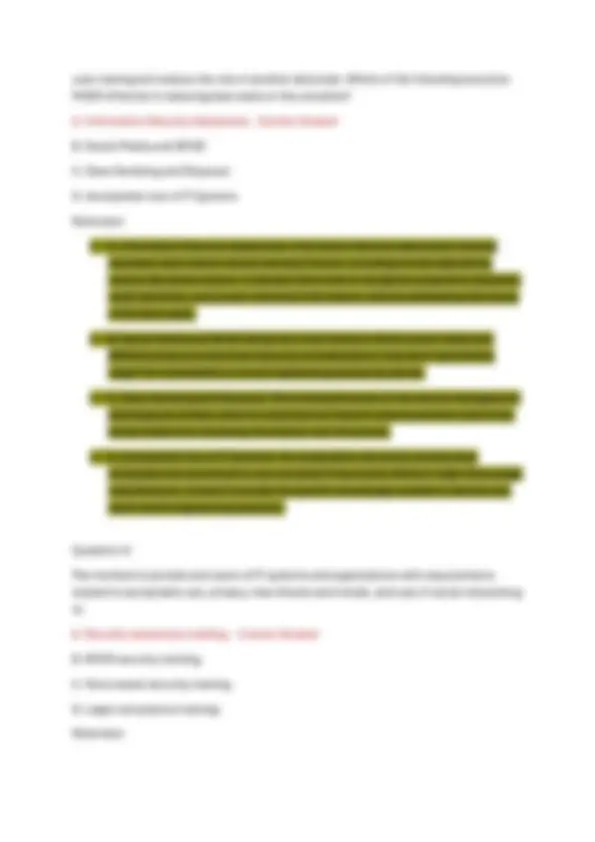

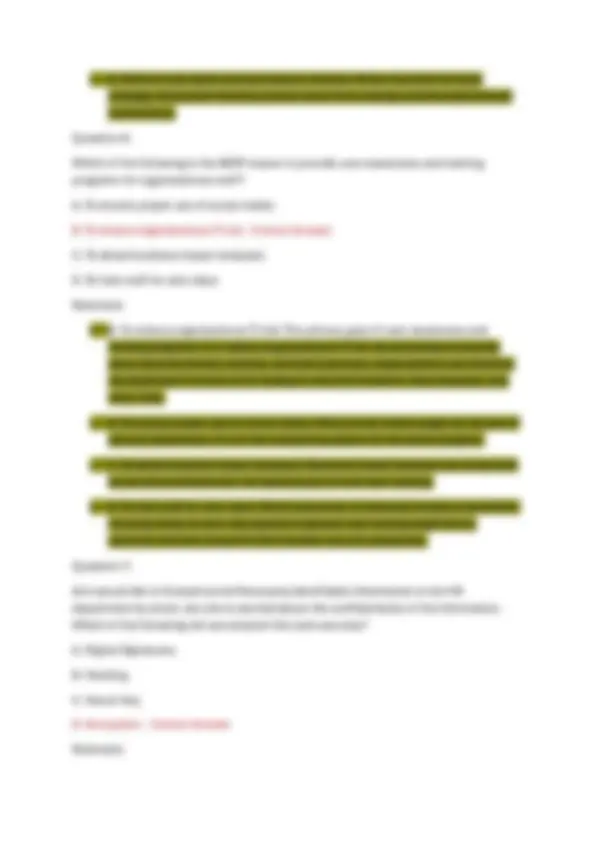
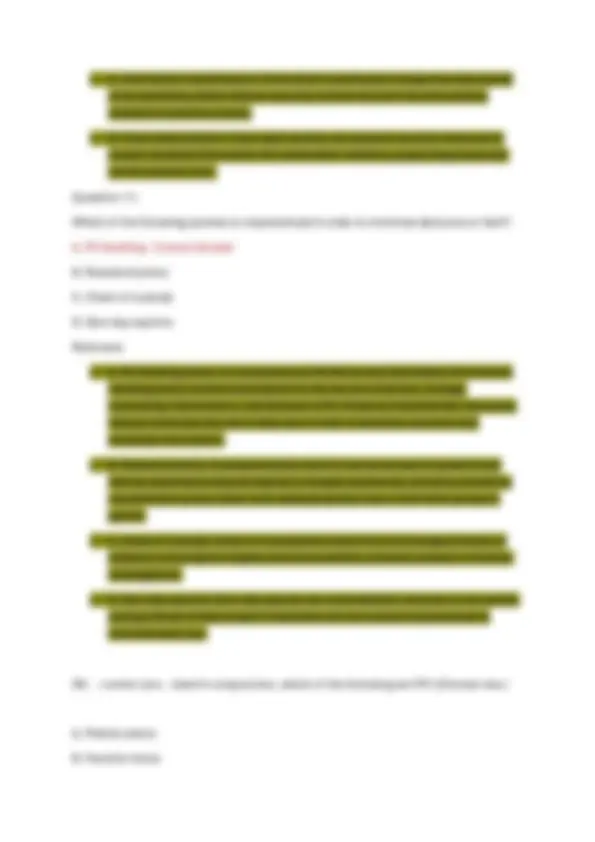



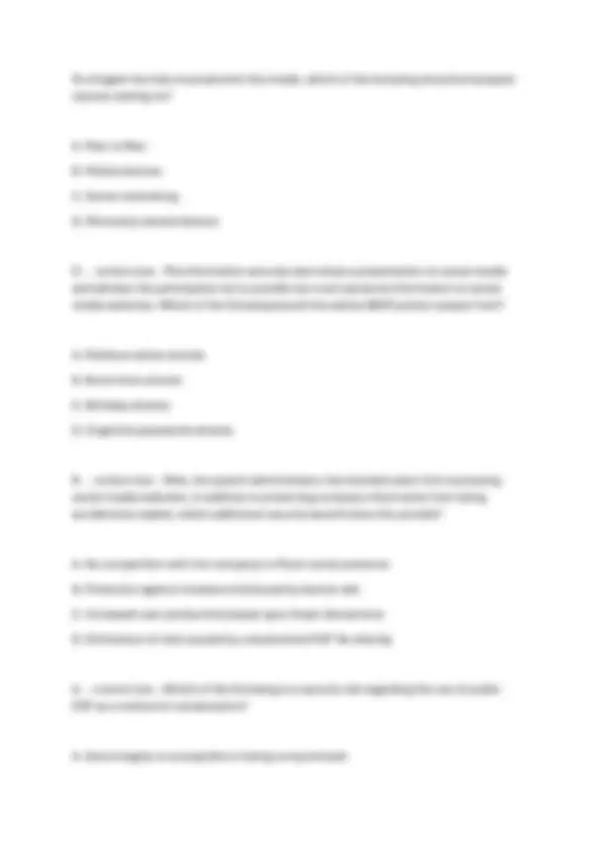







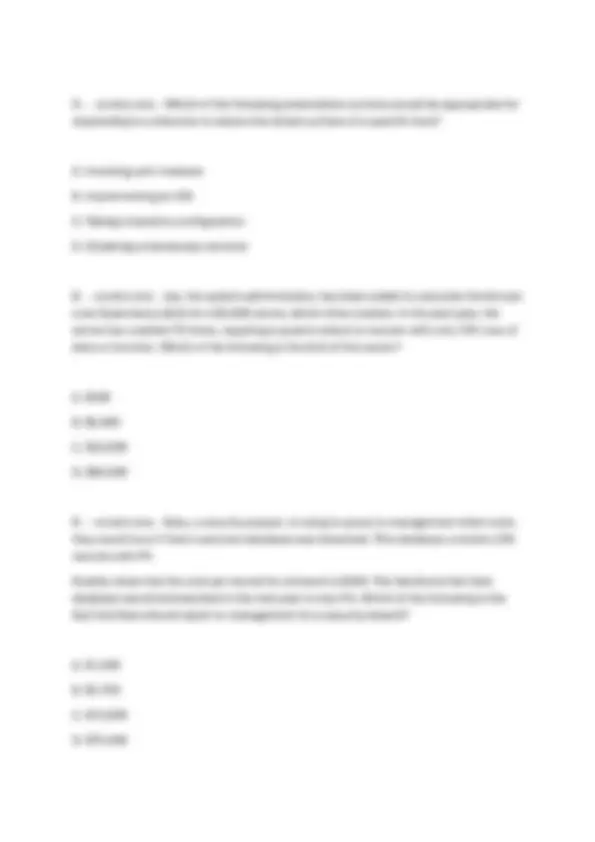
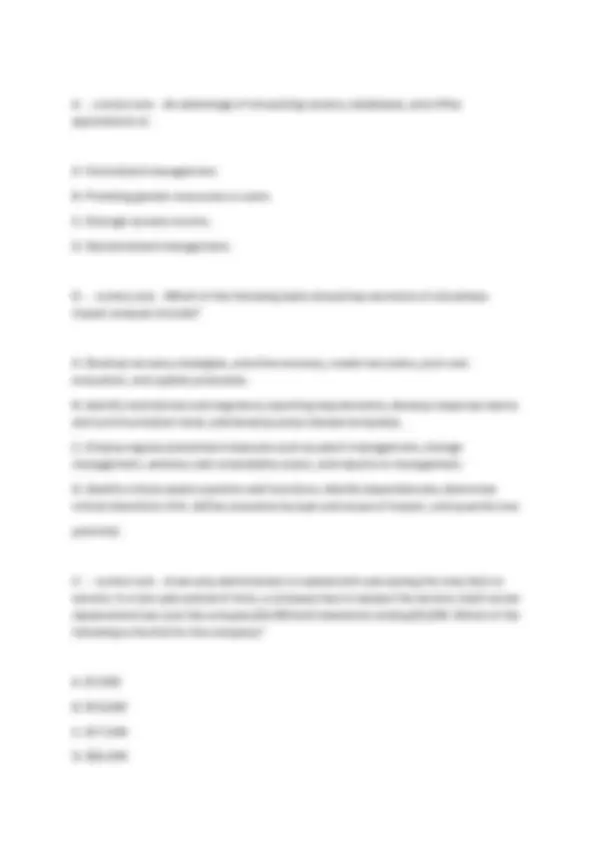

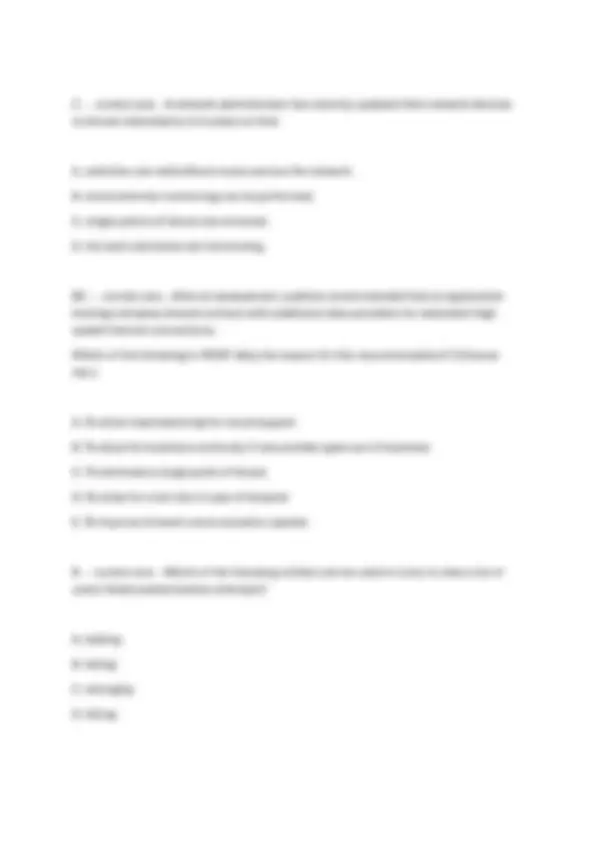
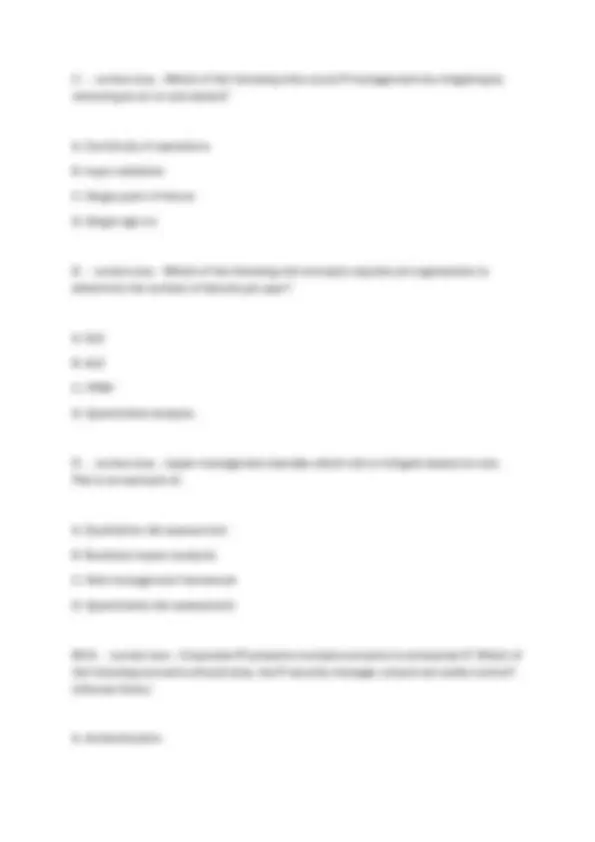




Study with the several resources on Docsity

Earn points by helping other students or get them with a premium plan


Prepare for your exams
Study with the several resources on Docsity

Earn points to download
Earn points by helping other students or get them with a premium plan
Community
Ask the community for help and clear up your study doubts
Discover the best universities in your country according to Docsity users
Free resources
Download our free guides on studying techniques, anxiety management strategies, and thesis advice from Docsity tutors
CompTIA Security+ 2025 Exam Review Guide: Complete Domain Analysis, Scenario-Based Practice, and Expert Insights
Typology: Exams
1 / 30

This page cannot be seen from the preview
Don't miss anything!























Here are the multiple-choice questions with rationales and the correct answers indicated: Question 1: Human Resources (HR) would like executives to undergo only two specific security training programs a year. Which of the following provides the BEST level of security training for the executives? (Choose two.) A. Acceptable use of social media B. Data handling and disposal C. Zero day exploits and viruses D. Phishing threats and attacks - Correct Answer E. Clean desk and BYOD F. Information security awareness - Correct Answer Rationale:
End-user awareness training for handling sensitive personally identifiable information would include secure storage and transmission of customer: A. Date of birth. - Correct Answer B. First and last name. - Correct Answer C. Phone number. - Correct Answer D. Employer name. Rationale: Options A, B, and C all constitute Personally Identifiable Information (PII). End-user awareness training on handling sensitive PII would cover the secure storage and transmission of all data that could directly or indirectly identify an individual. This includes:
A - - correct ans- - What is the term for the process of luring someone in (usually done by an enforcement officer or a government agent)? A. Enticement B. Entrapment C. Deceit D. Sting B - - correct ans- - In which of the following categories would creating a corporate privacy policy, drafting acceptable use policies, and group based access control be classified? A. Security control frameworks B. Best practice C. Access control methodologies D. Compliance activity B - - correct ans- - Which of the following is the process in which a law enforcement officer or a government agent encourages or induces a person to commit a crime when the potential criminal expresses a desire not to go ahead? A. Enticement B. Entrapment C. Deceit D. Sting C - - correct ans- - Results from a vulnerability analysis indicate that all enabled virtual terminals on a router can be accessed using the same password. The company's network device security policy mandates that at least one virtual terminal have a
different password than the other virtual terminals. Which of the following sets of commands would meet this requirement? A. line vty 0 6 P@s5W0Rd password line vty 7 Qwer++!Y password B. line console 0 password password line vty 0 4 password P@s5W0Rd C. line vty 0 3 password Qwer++!Y line vty 4 password P@s5W0Rd D. line vty 0 3 password Qwer++!Y line console 0 password P@s5W0Rd A - - correct ans- - Why would a technician use a password cracker? A. To look for weak passwords on the network B. To change a user's passwords when they leave the company C. To enforce password complexity requirements D. To change user's passwords if they have forgotten them B - - correct ans- - Which of the following security concepts would Sara, the security administrator, use to mitigate the risk of data loss? A. Record time offset B. Clean desk policy C. Cloud computing D. Routine log review AE - - correct ans- - The manager has a need to secure physical documents every night, since the company began enforcing the clean desk policy. The BEST solution would include: (Choose two.) A. Fire- or water-proof safe. B. Department door locks.
A. Cross-platform compatibility issues between personal devices and server-based applications B. Lack of controls in place to ensure that the devices have the latest system patches and signature files C. Non-corporate devices are more difficult to locate when a user is terminated D. Non-purchased or leased equipment may cause failure during the audits of company-owned assets C - - correct ans- - Several employees submit the same phishing email to the administrator. The administrator finds that the links in the email are not being blocked by the company's security device. Which of the following might the administrator do in the short term to prevent the emails from being received? A. Configure an ACL B. Implement a URL filter C. Add the domain to a block list D. Enable TLS on the mail server C - - correct ans- - A security researcher wants to reverse engineer an executable file to determine if it is malicious. The file was found on an underused server and appears to contain a zero-day exploit. Which of the following can the researcher do to determine if the file is malicious in nature? A. TCP/IP socket design review B. Executable code review C. OS Baseline comparison D. Software architecture review C - - correct ans- - A security administrator has concerns about new types of media which allow for the mass distribution of personal comments to a select group of people.
To mitigate the risks involved with this media, which of the following should employees receive training on? A. Peer to Peer B. Mobile devices C. Social networking D. Personally owned devices D - - correct ans- - The information security team does a presentation on social media and advises the participants not to provide too much personal information on social media websites. Which of the following would this advice BEST protect people from? A. Rainbow tables attacks B. Brute force attacks C. Birthday attacks D. Cognitive passwords attacks B - - correct ans- - Pete, the system administrator, has blocked users from accessing social media websites. In addition to protecting company information from being accidentally leaked, which additional security benefit does this provide? A. No competition with the company's official social presence B. Protection against malware introduced by banner ads C. Increased user productivity based upon fewer distractions D. Elimination of risks caused by unauthorized P2P file sharing A - - correct ans- - Which of the following is a security risk regarding the use of public P2P as a method of collaboration? A. Data integrity is susceptible to being compromised.
A. Policies B. Procedures C. Metrics D. Standards C - - correct ans- - Which of the following is an attack vector that can cause extensive physical damage to a datacenter without physical access? A. CCTV system access B. Dial-up access C. Changing environmental controls D. Ping of death A - - correct ans- - A company that purchased an HVAC system for the datacenter is MOST concerned with he following: A. Availability B. Integrity C. Confidentiality D. Fire suppression C - - correct ans- - Which of the following should be connected to the fire alarm system in order to help prevent the spread of a fire in a server room without data loss to assist in an FM-200 deployment? A. Water base sprinkler system B. Electrical C. HVAC
D. Video surveillance B - - correct ans- - Which of the following is a security benefit of providing additional HVAC capacity or increased tonnage in a datacenter? A. Increased availability of network services due to higher throughput B. Longer MTBF of hardware due to lower operating temperatures C. Higher data integrity due to more efficient SSD cooling D. Longer UPS run time due to increased airflow A - - correct ans- - Which of the following fire suppression systems is MOST likely used in a datacenter? A. FM- 200 B. Dry-pipe C. Wet-pipe D. Vacuum B - - correct ans- - When implementing fire suppression controls in a datacenter it is important to: A. Select a fire suppression system which protects equipment but may harm technicians. B. Ensure proper placement of sprinkler lines to avoid accidental leakage onto servers. C. Integrate maintenance procedures to include regularly discharging the system. D. Use a system with audible alarms to ensure technicians have 20 minutes to evacuate. D - - correct ans- - Which of the following should be considered to mitigate data theft when using CAT5 wiring?
C. HVAC system D. EMI shielding D - - correct ans- - Which of the following is an effective way to ensure the BEST temperature for all equipment within a datacenter? A. Fire suppression B. Raised floor implementation C. EMI shielding D. Hot or cool aisle containment BD - - correct ans- - Which of the following results in datacenters with failed humidity controls? (Choose two.) A. Excessive EMI B. Electrostatic charge C. Improper ventilation D. Condensation E. Irregular temperature B - - correct ans- - The datacenter manager is reviewing a problem with a humidity factor that is too low. Which of the following environmental problems may occur? A. EMI emanations B. Static electricity C. Condensation D. Dry-pipe fire suppression
C - - correct ans- - A technician is investigating intermittent switch degradation. The issue only seems to occur when the building's roof air conditioning system runs. Which of the following would reduce the connectivity issues? A. Adding a heat deflector B. Redundant HVAC systems C. Shielding D. Add a wireless network B - - correct ans- - A malicious person gained access to a datacenter by ripping the proximity badge reader off the wall near the datacenter entrance. This caused the electronic locks on the datacenter door to release because the: A. badge reader was improperly installed. B. system was designed to fail open for life-safety. C. system was installed in a fail closed configuration. D. system used magnetic locks and the locks became demagnetized. C - - correct ans- - A company is trying to implement physical deterrent controls to improve the overall security posture of their data center. Which of the following BEST meets their goal? A. Visitor logs B. Firewall C. Hardware locks D. Environmental monitoring B - - correct ans- - Pete, an IT Administrator, needs to secure his server room. Which of the following mitigation methods would provide the MOST physical protection?